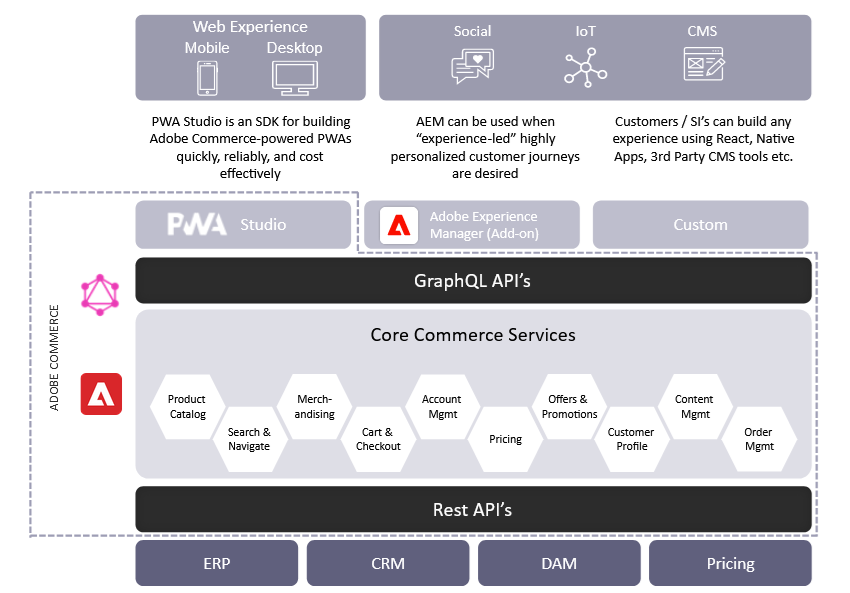
Headless Adobe Commerce Architecture: Unleashing Flexibility and Performance
In the ever-evolving landscape of e-commerce, merchants are constantly seeking solutions that offer both flexibility and performance. Adobe Commerce's headless architecture provides a compelling answer to this quest, allowing businesses to tailor their online presence to their unique needs. This article explores the world of headless e-commerce with Adobe Commerce, highlighting the benefits and options available to forward-thinking merchants.
The Power of Flexibility
Adobe Commerce's architecture is far from an all-or-nothing proposition. It offers merchants the freedom to select the right mix of solutions that align with their business goals and requirements. Whether it's creating a Progressive Web Application (PWA) for the primary site experience, utilizing Adobe Experience Manager for complex customer journeys, or experimenting with new touchpoints through a custom frontend, Adobe Commerce's headless architecture stands out for its flexibility.
The beauty of this approach is that these options are not mutually exclusive. Merchants can build their own frontend (the "head"), employ PWA Studio for web and mobile experiences, and/or harness Adobe Experience Manager for the presentation layer, all within a full or hybrid deployment strategy.
The Role of GraphQL APIs
Adobe Commerce has long supported headless deployments through REST APIs. While REST APIs are powerful, GraphQL APIs offer several advantages in the context of headless e-commerce. GraphQL enables faster development with an intuitive developer experience, greater flexibility to make changes without disrupting existing APIs, and improved performance by fetching only the necessary data. GraphQL is widely recognized as an industry standard for high-performing APIs, and expertise in its usage is readily available in the market.
领英推荐
The Progressive Web Application (PWA)
One of the compelling options within Adobe Commerce's headless architecture is building a Progressive Web Application (PWA) with PWA Studio. A PWA is inherently headless, decoupled from the commerce backend. PWA Studio empowers merchants to create high-performing, reliable, and cost-effective PWAs on top of Adobe Commerce, delivering exceptional web experiences for both mobile and desktop users. Over time, this approach is expected to become the default choice, surpassing the coupled storefront.
Adobe Experience Manager (AEM)
For merchants seeking powerful content and digital asset management, Adobe Experience Manager is an invaluable tool. AEM streamlines the process of bringing personalized, content-driven experiences to the market more rapidly. It blends digital asset management with the capabilities of machine learning, Adobe Sensei-powered content, and customer journey management, offering a compelling solution for businesses looking to enhance their online presence.
Custom Frontend Development
The final option in Adobe Commerce's headless architecture is building a custom frontend. This choice is ideal for businesses with in-house developers experienced in a specific frontend stack, such as React. By opting for a custom frontend, these businesses can harness their existing expertise, avoiding the need to learn Adobe Commerce's traditional frontend development methods.
However, this approach demands a strong commitment to customer or system integration, frontend development skills, and resources. Merchants may miss out on native compatibility with features like Page Builder, which is readily available with PWA Studio. Nevertheless, custom frontends empower businesses to explore innovations and experimentation, making it possible to delve into exciting opportunities such as augmented reality/virtual reality (AR/VR) or voice commerce without impacting their existing webstores.
In conclusion, Adobe Commerce's headless architecture provides a spectrum of options for merchants, combining flexibility, performance, and room for innovation. As the e-commerce landscape continues to evolve, this architecture positions businesses to adapt and thrive in a dynamic online marketplace. Whether it's embracing the PWA, leveraging Adobe Experience Manager, or building a custom frontend, Adobe Commerce offers a robust platform for crafting tailored and high-performing digital experiences.
#cloud #adobe #adobeexperrience #commerce #adobecommerce